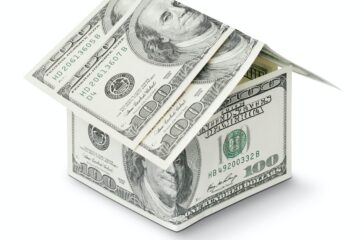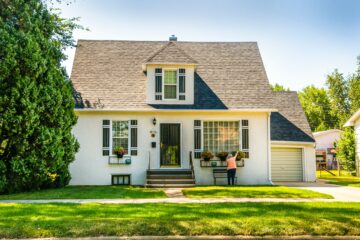Paying a mortgage is not quite the same as paying rent. When you have a mortgage payment you are responsible for a lot more than when you are a renter. When you pay rent, you simply pay to live there. The owner or manager of the property is responsible for any maintenance, repairs, taxes, etc. But when you own the home, you are responsible for all of those things. So in order to better explain this, let me show you what actually goes into a mortgage payment.
Case Study Example
For the rest of this article, let’s look at the example of Robbie and Christine.
Robbie and Christine just purchased a perfectly regular home. Here are the details of their purchase:
- $428,000 purchase price
- $10,000 down payment
- 30-year loan
- 6.00% interest rate
- Property taxes of 1% of home value ($4,280/year) ($357/month)
- Property insurance of 0.5% of property value ($2,140/year) ($178/month)
- Homeowners Association (HOA) dues of $1,200 per year ($100/month)
- Private Mortgage Insurance (PMI) of $2,100/year ($175/month)
Their mortgage payment is $3,316.12 per month.
Here’s the breakdown of their monthly mortgage payment:
Now that we know what Robbie and Christine’s mortgage payment looks like, let’s look at what each portion of the mortgage payment means and what it does for them.
(1) Principal
The principal of a mortgage payment is the best part. The amount that you pay in principal is the amount that you actually pay toward owning the property. (This is true for all types of loans, not just mortgages.)
What this means is that after their first payment, Robbie and Christine will own $416.12 more of the house than they did the year before.
Also, every month that goes by, they will be able to pay a little more toward the principal than the previous month.
This is because they are paying down the total amount borrowed each month, which means that they have to pay less interest.
Here’s how it looks for the first year that they own this house:
As you can see, each month that goes by, they pay a little more in principal. This continues until the entire loan balance is paid off.
(2) Interest
Interest is simply the cost of borrowing money. You have to pay a “charge” to the bank or mortgage lender in order to borrow their money so that you can buy the house now. That “charge” is the interest.
Interest works just the opposite of principal though. Each month that goes by, you pay a little less in interest. This is because you pay down the principal a little each month so you owe a little less money each month that goes by.
This is the same for any type of loan, btw.
Here is how Robbie and Christine’s payments look for the first year.
As you can see, each month that goes by, they pay a little less in interest. This will continue until they pay $0 interest when the loan is fully paid off.
(3) Taxes
As the old saying goes, there are only two things in life for certain: death and taxes.
You will ALWAYS have to pay taxes on your home. Even if you have it paid off completely, if you stop making your tax payments, the county that you live in will take your home from you.
When you have a fixed rate mortgage (like Robbie and Christine) your mortgage payment will probably stay close to the same throughout the life of your loan. However, if it does change at all, it will probably be due to your taxes increasing on your home.
Just remember, PAY YOUR TAXES!
(4) Insurance
You will also have to carry insurance on your home as well. It is a requirement of home lenders to make sure that you have insurance.
The reason that you are required to have insurance on your home is because if the house were to be destroyed, then the bank wants to know that they will have collateral for their loan. They want to make sure that the home could be replaced. And you should want this as well.
Homeowners insurance will vary based on where you live. You might be required to have flood insurance, fire insurance, etc. that the next person may not. But you have to have homeowners insurance at a minimum.
(5) HOA Dues
You may or may not have HOA dues. If you live in an HOA, you very well might have extra payments that you have to make to help with the landscaping, sidewalks, pool, tennis courts, etc.
But not everyone will have HOA dues.
If Robbie and Christine did not live in an HOA, their mortgage payment would go from $3,316.12 to $3,216.12
(6) Private Mortgage Insurance (PMI)
PMI can be a really frustrating part of having a mortgage.
PMI is the insurance that you pay to insure the lender (not insure yourself). You will have to pay PMI if you did not put down at least 20% on your home.
The thinking (by the bank) of why they charge you this fee is because since you did not have very much skin in the game, there is a higher chance that you could default on your mortgage. Therefore, they charge you an extra premium if you did not put down at least 20%.
The good news is, if you have a conventional mortgage, when you pay down your loan over time by at least 20% or if the property value increases at least 20%, you can ask your lender to remove the PMI.
It might take a little leg work and you might have to pay for an appraisal, but you can do it.
So for Robbie and Christine, if they were to pay their mortgage down to $342,400 they can have the PMI removed. This would decrease their mortgage by $175/month.
Final Thoughts
Having a mortgage is not all sunshine and rainbows. There are several housing costs that you should consider. But it is a really great step in becoming financially stable and building wealth as opposed to renting.
But if you are not ready for all the headaches of buying a home and then maintaining a home, you probably should not buy just yet.
But if you are looking to purchase a home I will give you the info to make sure that you have the knowledge to make a good and informed decision!
You can do this!
I believe in you!
Until next time!



0 Comments